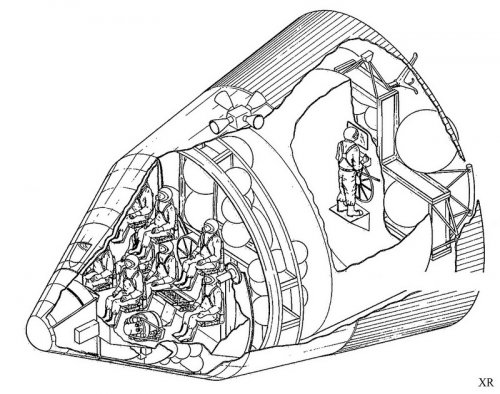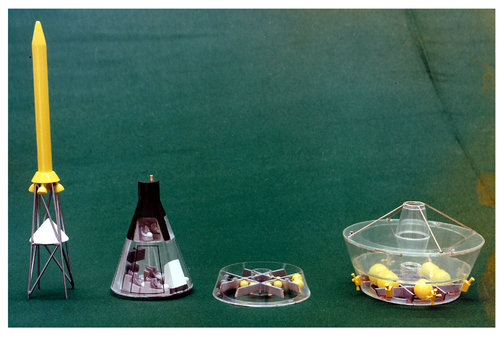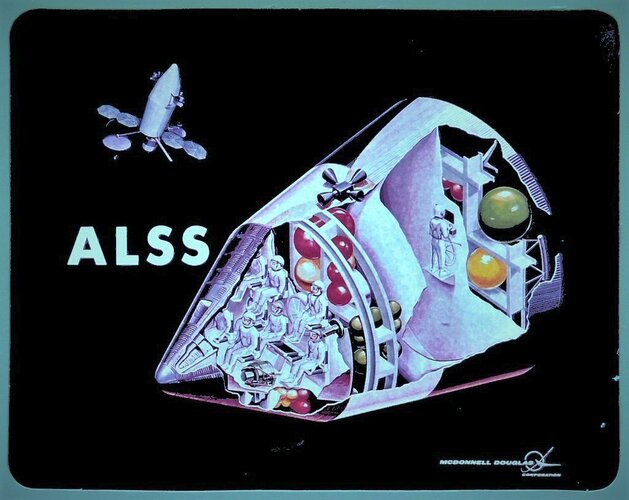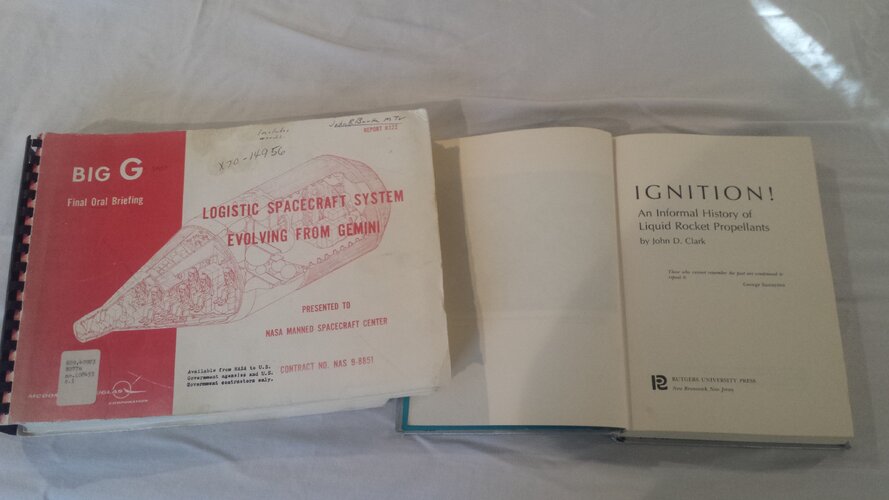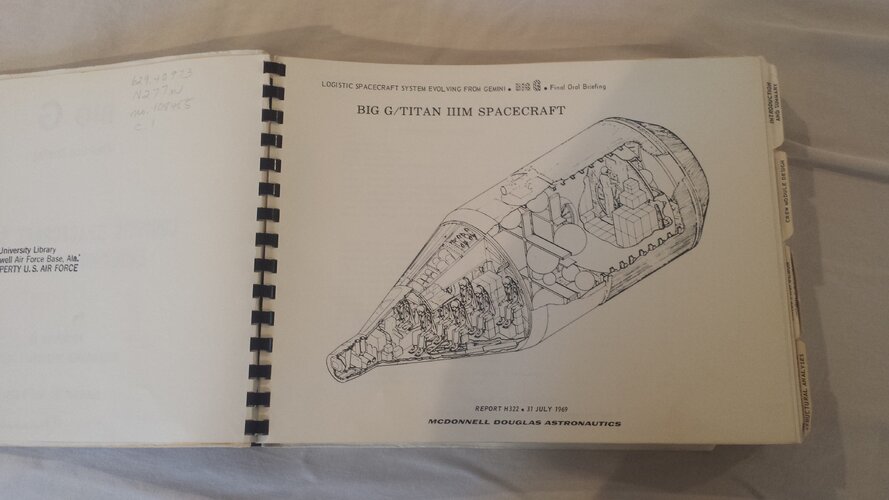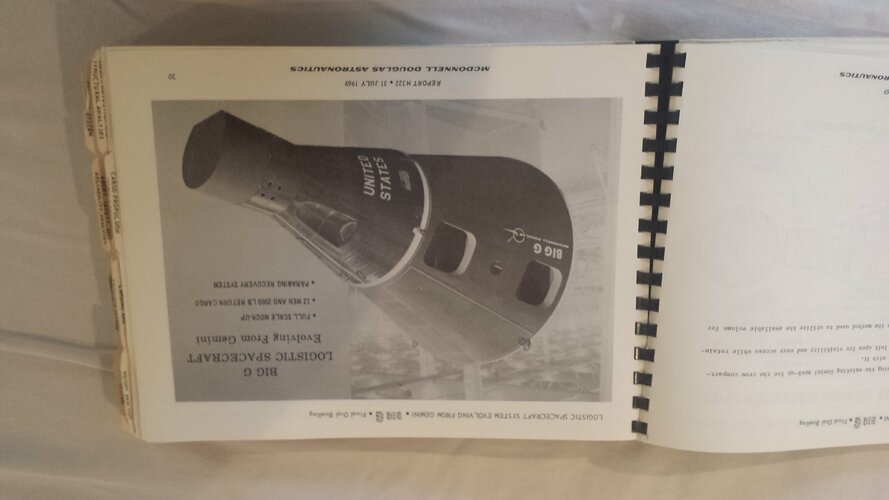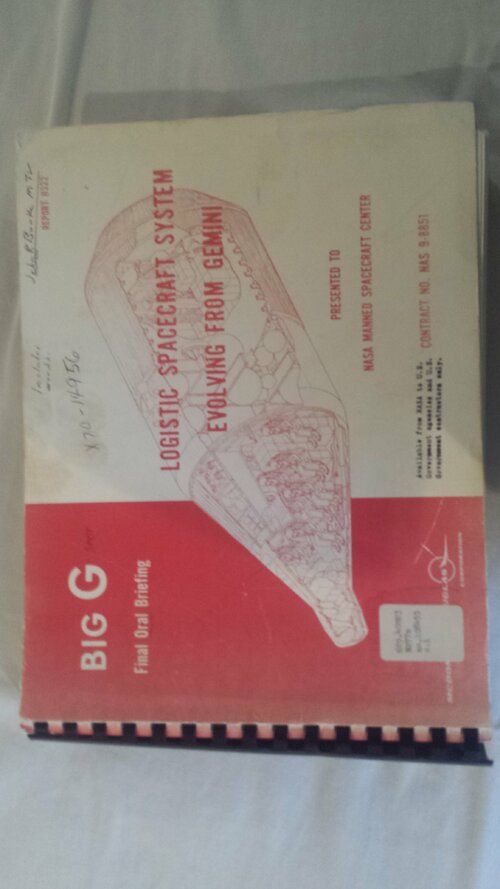Very interesting article. Indeed the mystery remains of why a block III Apollo CSM was out of the running late 1971. My own theory is that Apollo was not considered a viable space station logistic vehicle. Big Gemini was the absolute minimum space station logistic vehicle, together with a "fat Dynasoar" that added wings and a payload bay (they called it the glider, because it had no engines). Both were launched by large Titan III vehicles.
You are using an out of date browser. It may not display this or other websites correctly.
You should upgrade or use an alternative browser.
You should upgrade or use an alternative browser.
Big Gemini
- Thread starter Michel Van
- Start date
- Joined
- 13 August 2007
- Messages
- 8,446
- Reaction score
- 11,001
Archibald said:Very interesting article. Indeed the mystery remains of why a block III Apollo CSM was out of the running late 1971. My own theory is that Apollo was not considered a viable space station logistic vehicle. Big Gemini was the absolute minimum space station logistic vehicle, together with a "fat Dynasoar" that added wings and a payload bay (they called it the glider, because it had no engines). Both were launched by large Titan III vehicles.
Apollo CSM block III had different goal Apollo Application Program
it primary task was to serve longer in space and support AAP hardware (wet Skylab), with RCS and Power
more Fuel for more powerful fuel cell, advance Life support system. and more Fuel for RCS.
but as Apollo and AAP died were no need for CSM Block III, rest fly with leftovers from CSM production..
- Joined
- 26 September 2008
- Messages
- 1,960
- Reaction score
- 746
Archibald said:Very interesting article. Indeed the mystery remains of why a block III Apollo CSM was out of the running late 1971. My own theory is that Apollo was not considered a viable space station logistic vehicle. Big Gemini was the absolute minimum space station logistic vehicle, together with a "fat Dynasoar" that added wings and a payload bay (they called it the glider, because it had no engines). Both were launched by large Titan III vehicles.
I don't get that either. Big Gemini was going to be essentially new, so that meant higher development costs. But it did have the advantage that they could put more volume behind the cockpit. I think that McD could legitimately argue that they had done all the engineering work for the Gemini B, so that removed a key element of risk.
The Apollo CSM could not be expanded in volume. To add anything to it meant adding a pressurized cargo pod that would dock on front. That would have blocked the viewport for further dockings. Not impossible to address, but essentially by solving one problem (need for volume) they created a second one (need for new docking solution).
And of course keep in mind that North American may not have been at the top of their game. They might have been devoting all their resources to Apollo and not put their A-team on post-Apollo options. McD didn't have that problem by 1968. Their Gemini people had less to do with the Gemini B, so maybe they could put more resources on the Big Gemini proposal.
Anyway, feel free to support your local British Interplanetary Society.
XP67_Moonbat
ACCESS: Top Secret
- Joined
- 16 January 2008
- Messages
- 2,271
- Reaction score
- 543
Thanks Dwayne! My Haynes Gemini book is missing a bonus chapter
- Joined
- 26 September 2008
- Messages
- 1,960
- Reaction score
- 746
XP67_Moonbat said:Thanks Dwayne! My Haynes Gemini book is missing a bonus chapter
David Baker who did the Gemini book is the editor of Spaceflight and was very happy to get my article.
XP67_Moonbat
ACCESS: Top Secret
- Joined
- 16 January 2008
- Messages
- 2,271
- Reaction score
- 543
Nice!
XP67_Moonbat
ACCESS: Top Secret
- Joined
- 16 January 2008
- Messages
- 2,271
- Reaction score
- 543
From our very own Blackstar! Enjoy!
http://www.thespacereview.com/article/2879/1
http://www.thespacereview.com/article/2879/1
- Joined
- 13 August 2007
- Messages
- 8,446
- Reaction score
- 11,001
i found this picture on Flickr
sadly the person who uploaded it, not answer my question on Source of this picture
on first look it like Big Apollo capsule
but second look you notice the Gemini Doors and Life-support system of Gemini capsule.
can this be variation on Big G ?
sadly the person who uploaded it, not answer my question on Source of this picture
on first look it like Big Apollo capsule
but second look you notice the Gemini Doors and Life-support system of Gemini capsule.
can this be variation on Big G ?
Attachments
- Joined
- 3 June 2006
- Messages
- 3,094
- Reaction score
- 3,963
Source: http://www.aerospaceprojectsreview.com/blog/?p=2452
 B)
B)
SAustin16
Bravo to All Brave Test Pilots
- Joined
- 12 January 2008
- Messages
- 139
- Reaction score
- 37
Blackstar,
Congratulations on an excellent article regarding one of my favorite subjects. Great to see Archipeppe's beautiful illustrations included (had not seen these versions of Big G previously).
Well done, Sir.
Congratulations on an excellent article regarding one of my favorite subjects. Great to see Archipeppe's beautiful illustrations included (had not seen these versions of Big G previously).
Well done, Sir.
- Joined
- 13 August 2007
- Messages
- 8,446
- Reaction score
- 11,001
thx, fightingirish
for notice me on source on that Big G picture
for notice me on source on that Big G picture
archipeppe
ACCESS: Top Secret
- Joined
- 18 October 2007
- Messages
- 2,431
- Reaction score
- 3,152
SAustin16 said:Blackstar,
Congratulations on an excellent article regarding one of my favorite subjects. Great to see Archipeppe's beautiful illustrations included (had not seen these versions of Big G previously).
Well done, Sir.
Thank you for the words of appreciation.
Ciao
Giuseppe
archipeppe
ACCESS: Top Secret
- Joined
- 18 October 2007
- Messages
- 2,431
- Reaction score
- 3,152
Would Big Gemini have allowed a shirt sleeve environment?
The actual Gemini did allowed a shirt sleeve environment, it is easy to understand that long duration mission like the Gemini 7A simply could't happened if astronauts would fit pressurized suits alla the time.
Considering that the BigG would have a far greater volume than the actual Gemini there is no reason to not have the same shirt sleeve environment.
jeffb
ACCESS: Top Secret
- Joined
- 7 October 2012
- Messages
- 1,280
- Reaction score
- 1,937
Great thread guys, Big G one of my real favorites. Fabulous diagrams Archipeppe, great work!
Here's a little piece on flying the gusmobile..
https://www.airspacemag.com/flight-today/flying-the-gusmobile-218187/
Here's a little piece on flying the gusmobile..
https://www.airspacemag.com/flight-today/flying-the-gusmobile-218187/
archipeppe
ACCESS: Top Secret
- Joined
- 18 October 2007
- Messages
- 2,431
- Reaction score
- 3,152
Great thread guys, Big G one of my real favorites. Fabulous diagrams Archipeppe, great work!
Here's a little piece on flying the gusmobile..
https://www.airspacemag.com/flight-today/flying-the-gusmobile-218187/
Thank you Jeff!
Something just dawned on me...
MOL was similar in diameter to the Titan core carrying it, that is, 3.05 m. It can be clearly seen in the 1966 flight test pictures.
By contrast,
Archipeppe artwork and other sources says that Big G diameter was far superior, up to 4.3 m. In turn this mean that unlike MOL, Big G would make a Titan III-M look like having a hammerhead fairing - as on Titan III-E Centaur and Titan IV.
Never thought about this before, silly me.
Note: for you imperial units aficionados, 3.05 m is 10 ft while 14 ft is 4.27 m.
MOL was similar in diameter to the Titan core carrying it, that is, 3.05 m. It can be clearly seen in the 1966 flight test pictures.
By contrast,
Archipeppe artwork and other sources says that Big G diameter was far superior, up to 4.3 m. In turn this mean that unlike MOL, Big G would make a Titan III-M look like having a hammerhead fairing - as on Titan III-E Centaur and Titan IV.
Never thought about this before, silly me.
Note: for you imperial units aficionados, 3.05 m is 10 ft while 14 ft is 4.27 m.
Last edited:
- Joined
- 9 October 2009
- Messages
- 21,973
- Reaction score
- 13,623
Note: for you imperial units aficionados, 3.05 m is 10 ft while 14 ft is 4.27 m.
We thank you.
- Joined
- 26 September 2008
- Messages
- 1,960
- Reaction score
- 746
I've posted this to another forum, but the entire multi-volume Big-G contract proposal is in a publicly accessible archive in Houston and it is in very good condition. It would require some work to go there and copy and scan it, but it's a really good, thick document.
Orionblamblam, we need your skills !!! I think a lot of people (including my little self) would be willing to pay for that thing. There is a good business case there.
It'd be strange to go all the way to Houston when I have copies of all volumes sitting on a shelf. the only real problem is, IIRC, that they're marked "Gov't employees and contractors only." If it can be shown to be publicly available somewhere, then that's different...
Crackerbarrel67
ACCESS: Restricted
- Joined
- 9 July 2020
- Messages
- 10
- Reaction score
- 24
Crackerbarrel67
ACCESS: Restricted
- Joined
- 9 July 2020
- Messages
- 10
- Reaction score
- 24
My pleasure!
Crackerbarrel67
ACCESS: Restricted
- Joined
- 9 July 2020
- Messages
- 10
- Reaction score
- 24
Who knows...Ive been digging around the web for years....Where did you got thaaaaat ?
Bhurki
ACCESS: Secret
- Joined
- 16 July 2020
- Messages
- 345
- Reaction score
- 382
Its from somewhere in this thread..Where did you got thaaaaat ?
Eyes Turned Skywards
"When once you have tasted flight, you will forever walk the earth with your eyes turned skyward, for there you have been, and there you will always long to return." --Commonly attributed to Leonardo da Vinci Truth is Life and I have been working on this for a while, and we're finally ready to...
www.alternatehistory.com
- Joined
- 2 May 2007
- Messages
- 496
- Reaction score
- 1,962
- Joined
- 29 September 2006
- Messages
- 1,793
- Reaction score
- 1,360
Possibly - the manufacturer is McDonnell Douglas, and McDonnell was the Gemini manufacturer.View attachment 667275i found this picture on Flickr
sadly the person who uploaded it, not answer my question on Source of this picture
on first look it like Big Apollo capsule
but second look you notice the Gemini Doors and Life-support system of Gemini capsule.
can this be variation on Big G ?
afcivileng
I really should change my personal text
- Joined
- 27 November 2017
- Messages
- 4
- Reaction score
- 8
- Joined
- 27 December 2005
- Messages
- 17,748
- Reaction score
- 26,414
Cool! Do you have regular access to the library? I might need your helpFound these in the USAF Library at Maxwell AFB
The Saturns were ARMY rockets-and air farce made sure they died with the ABMA. Now Starship looks to kill winged concepts like how Shuttle killed Saturn. They should have listened to my American Energia-Buran concept. Now...It may be a Starship topped with a Big G that is all the rage and due for a comeback...getting F-35's budget I hope!Brickmuppet said:My good sir.
I had heard about "Big G' but the "Advanced Big Gemini" is intriguing.The service module has more working volume than the MOL station
or its possibly USAF want used it as "Super MOL" ?
INT-20 is a Saturn IB
i wish they had taken Saturn INT-20 with Big G and not the Shuttle
Wrong on every point.1. The Saturns were ARMY rockets-and air farce made sure they died with the ABMA.
2. Now Starship looks to kill winged concepts like how Shuttle killed Saturn.
3. They should have listened to my American Energia-Buran concept.
4. Now...It may be a Starship topped with a Big G that is all the rage and due for a comeback...getting F-35's budget I hope!
1. Saturn died because they were too expensive. NASA killed them. They were so expensive, it was cheaper to develop a new Titan III derivative vs using a Saturn IB.
2. Shuttle didn't kill Saturn. The choice was Shuttle or nothing. Saturn was never on the table. Starship is not "killing" winged concepts. Economics is.
3. Nobody would or should listen to you. You don't have a positive standing within the spaceflight community.
4. Starship is a spacecraft itself. No need to topped with another one.
5. Big G was only a rage among the fringe. There is no reason for a comeback. NASA's budget is going to stay flat and won't see an Apollo project and funding again.
Last edited:
Wrong on every point.1. The Saturns were ARMY rockets-and air farce made sure they died with the ABMA.
2. Now Starship looks to kill winged concepts like how Shuttle killed Saturn.
3. They should have listened to my American Energia-Buran concept.
4. Now...It may be a Starship topped with a Big G that is all the rage and due for a comeback...getting F-35's budget I hope!
1. Saturn died because they were too expensive. NASA killed them. They were so expensive, it was cheaper to develop a new Titan III derivative vs using a Saturn IB.
2. Shuttle didn't kill Saturn. The choice was Shuttle or nothing. Saturn was never on the table. Starship is not "killing" winged concepts. Economics is.
3. Nobody would or should listen to you. You don't have a positive standing within the spaceflight community.
4. Starship is a spacecraft itself. No need to topped with another one.
5. Big G was only a rage among the fringe. There is no reason for a comeback. NASA's budget is going to stay flat and won't see an Apollo project and funding again.
1) Saturn 1 wasn't that expensive compared to Titan III and had it had a higher flight rate the costs would have come down. Keep in mind the Air Force 'accounting' for Titan III was VERY dicey considering how little commonality it actually had with the Titan missile. This was exposed when they built the Titan IV and couldn't 'massage' the accounting with "current missile" budgets.
2) Agree that Shuttle didn't kill Saturn but there was a 'choice' to be made and it was specifically a NASA goal to toss all the Apollo hardware in favor of a "new" system. NASA killed Saturn because it didn't do what they wanted and more specifically because Congress wasn't going to pay for any more Saturn V's which was actually the only "Saturn" they cared about.
2a) Starship isn't "killing" anything and it's questionable if it will actually become operational. The sad part is how many people simply dismiss the actual market and operational requirements and 'assume' that if Starship flies that somehow all policy and direction will suddenly change to use it. Not how it works.
2b) "Winged" (actually more accurately "lifting") vehicles are fine as you point out and in no danger of Starship surplanting them. Interestingly several die-hard Musk fans have come out in support of vehicles like Dreamchaser.
3) I suspect more to the point it's about not quite understanding why and how Energia, Gemini, Saturn et-al came about and why more than anything. There's a specific and general set of background "needs" and "requirements" that Saturn, the Shuttle (and Energia/Buran) and other launch vehicles have met that allowed them to come into operation. Starship has almost none of those, meets almost none of them and only has a billionaire funding source (that can lobby and cajole government money to since he can't in fact support it himself) that is willing to spend money on the concept no matter if it actually address' the actual needs or not. Anyone who does NOT see the Shuttle program parallels (only more private sector with less well thought out planning and less over-sight) just isn't looking.
4) "Starship" doesn't exist yet all we have is a very minimal prototype mold-line with none of the needed operational systems or even their mass simulators. So far it's proven it is a bad design that lacks several key features and is NOT reusable in operation.
5) "Won't see an Apollo project and funding again" which is a damn good thing! Apollo was a wonderful aberration but it arguably tainted NASA with ambitions far beyond what the nation could support or fund and has directly led to our 'stagnation' for the past decades. The timetable and goal of our "Apollo" (rather than the original "Apollo" program) could only be reached in an unsustainable and outrageously expensive manner that would broke no delays or side-tracks and left a "legacy" system that was really only good for doing that one specific thing and nothing else. We might have come back even so but that legacy also infected the culture and organization of NASA itself and that is something the agency has never recovered from despite several near attempts to do so.
It's far past time we moved on and actually built up a credible and sustainable space program that embraces the commercial as well as the government needs and builds both up step-by-step.
Randy
Nik
ACCESS: Top Secret
- Joined
- 15 July 2009
- Messages
- 1,269
- Reaction score
- 1,062
Back when I first read of the Gemini variant with hatch through heatshield, my reaction was, quite reasonably, 'WTF ??'
But, apparently, it was okay...
Was a much thinner, hence much lighter, heatshield with similar 'hatchery' considered for post-Lunar LEO Apollo ? Would that have allowed a toroidal Service mini-Module and a hefty hab-module between Command and a shortened Service Module ? Said hab and short-SM modules perhaps being left docked to growing space-station while CM used its mini-SM to de-orbit ??
FWIW, my understanding is that Shuttle dimensions, hence design compromises, were driven by the huge 'cargo bay' demands of the NRO-ish TLAs, who wanted to loft surveillance stuff with really, really big optics etc at short notice. By cruel irony, meeting that extravagant specification delayed Shuttle so much the TLAs perforce went back to 'expendables'...
But, apparently, it was okay...
Was a much thinner, hence much lighter, heatshield with similar 'hatchery' considered for post-Lunar LEO Apollo ? Would that have allowed a toroidal Service mini-Module and a hefty hab-module between Command and a shortened Service Module ? Said hab and short-SM modules perhaps being left docked to growing space-station while CM used its mini-SM to de-orbit ??
FWIW, my understanding is that Shuttle dimensions, hence design compromises, were driven by the huge 'cargo bay' demands of the NRO-ish TLAs, who wanted to loft surveillance stuff with really, really big optics etc at short notice. By cruel irony, meeting that extravagant specification delayed Shuttle so much the TLAs perforce went back to 'expendables'...
Back when I first read of the Gemini variant with hatch through heatshield, my reaction was, quite reasonably, 'WTF ??'
But, apparently, it was okay...
Was a much thinner, hence much lighter, heatshield with similar 'hatchery' considered for post-Lunar LEO Apollo ? Would that have allowed a toroidal Service mini-Module and a hefty hab-module between Command and a shortened Service Module ? Said hab and short-SM modules perhaps being left docked to growing space-station while CM used its mini-SM to de-orbit ??
Didn't need it as the Apollo CM had a docking port and attachment on the nose whereas Gemini didn't
Which was kind of the whole 'problem' with Gemini it that it was never designed to actually be as versatile as it arguably was. It was meant to just be a 'larger' Mercury and kind of organically grew from there yet at the same time it wasn't really thought through since it was always going to be just a interim vehicle.
FWIW, my understanding is that Shuttle dimensions, hence design compromises, were driven by the huge 'cargo bay' demands of the NRO-ish TLAs, who wanted to loft surveillance stuff with really, really big optics etc at short notice. By cruel irony, meeting that extravagant specification delayed Shuttle so much the TLAs perforce went back to 'expendables'...
Actually the NRO (being super-secret at the time) wasn't directly contacted but as the 'face' organization for it the Air Force was and they essentially said "ya, whatever" to NASA's request for a large cargo bay and delta wings for cross range. The Air Force had no intention on actually using the Shuttle so they agreed to support NASA's requirement for a large cargo bay, (for Space Station modules) and agreed to the cross-range requirements that required the delta wings NASA wanted as well.
Several histories of the Shuttle point out that after this became known the head of the NRO (who was actually an Under-Secretary of the Air Force) asked for and met with NASA representatives and told them the Air Force "requirements" were possibly over-emphasized and that the "Intelligence payloads" likely didn't need that big a bay. Since NASA was the actual originator of the 'requirements' they ignored this in favor of the design they wanted. (Again he's "only" an Under-Secretary after all
It was actually pretty clear from the start to the NRO, ("intelligence" after all
Randy
Nik
ACCESS: Top Secret
- Joined
- 15 July 2009
- Messages
- 1,269
- Reaction score
- 1,062
"Didn't need it as the Apollo CM had a docking port and attachment on the nose whereas Gemini didn't..."
I meant in addition to the existing nose port, so could access hab-module attached where Service Module had been. Without doing a 'Morris Dance' and back-flip...
I meant in addition to the existing nose port, so could access hab-module attached where Service Module had been. Without doing a 'Morris Dance' and back-flip...

